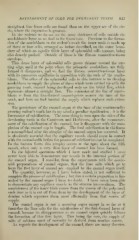Page 633 - My FlipBook
P. 633
DEVELOPMENT OF CORD FOR PERMANENT TEETH. 643
straightest line fewer cells are found than on the upper arc of the cir-
cle, where the expansion is greatest.
In the rodents we do not see the same thickness of cells outside the
ameloblastic layer as we find in the Carniv^ora. Previous to the forma-
tion of the ameloblasts in the rodent's tooth the inner tunic is made up
of three or four cells, arranged as before described, on the outer boun-
dary of which an equally thick layer of spheroidal cells appears, being
also densely packed. Outside of these is the fibrous connective-tissue
envelope.
This dense layer of spheroidal cells grows thinner toward the cut-
ting edge, until at the point wliere the prismatic ameloblasts are fully
formed it disappears, and we find the fibrous connective-tissue layer
with its numerous capillaries in apposition Avith the ends of the amelo-
blasts. The office of the spheroidal cells in this instance is to develop
ameloblasts to supply the places of those which were carried up with the
growing tooth, enamel being developed only on the labial face, which
represents almost a straight line. The extension of the line of amelo-
blasts is from the first-formed enamel-prism nearest the base of the
tooth, and here we find located the supply which replaces such exten-
sion.
The persistence of the enamel organ at the base of the continuously-
growing rodent's tooth has to my mind a peculiar signification : it is the
forerunner of calcification. The same thing is seen upon the sides of the
developing tooth in the Carnivora and Herbivora, after the commence-
ment of the calcification of the enamel, but it disappears with the com-
pletion of the enamel cap in length. The final calcification in thickness
is accomplished after the atrophy of the enamel organ has occurred. It
is absolutely essential that the capillary vessels should come in contact
with the enamel-cells before the process of calcification can be completed.
In the human fretus this atrophy occurs at the apex about the fifth
month, when only a very thin layer of enamel has been formed.
In the injected specimens which I have made and studied I have
never been able to demonstrate any vessels in the internal portion of
the enamel organ. I consider, from the experiments with the osmic-
acid preparations of enamel organs, that the lime salts which go to
form the first layer of enamel are supplied by the enamel organ itself.
The quantity, however, as I have before stated, is not sufficient to
complete the process of calcification l^ut that a certain proportion is fur-
;
nished by the enamel organ I have no (loul:)t. I have never been able
to demonstrate any capillary vessels in the stratum intermedium. The
nourishment of the inner tunic comes from the vessels of the pulp until
such time as it is cut off from them by the development of the layer of
dentine which separates them most effectually from that source of.'
supply.
The enamel organ is not a secreting organ except in so fiir as it
furnishes the lime salts for the calcification of the first-formed layer of
enamel, because its disappearance as an enamel organ quickly follows
the formation of this first layer. This being the case, the supply of
salts of calcium must of necessity be derived from another source.
As regards the development of the enamel, there are many theories.


